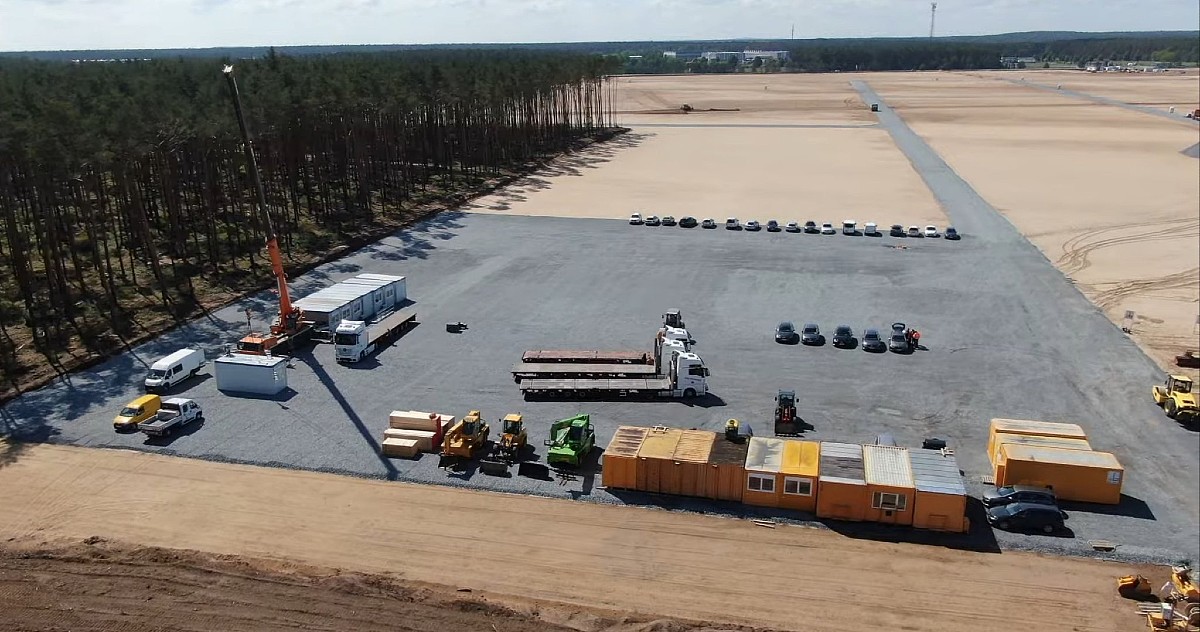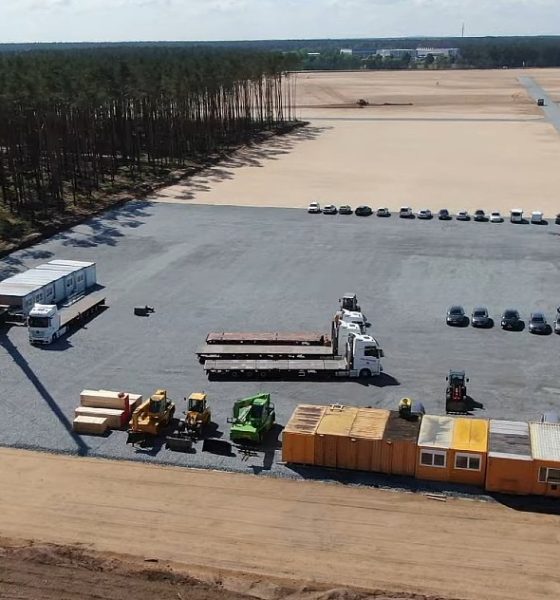

News
Tesla Gigafactory Berlin moves one step closer to groundbreaking event
Tesla’s Giga Berlin site is beginning to show some hints that a potential groundbreaking event may be taking place sooner than expected. Recent photos of the Gigafactory Berlin complex reveal that construction crews are seemingly preparing to set up the initial stages of the Model Y facility by performing several tests on the site.
A Tweet from @Gf4Tesla indicates that crews are preparing for a load test to make sure the area’s ground is stable and ready for foundation work. Several heavy equipment are at the Giga Berlin site maneuvering large pieces of structural steel on a large expanse of what appear to be gravel.
Load testing helps create confidence for construction crews. The results of the tests can indicate whether the property is deteriorating or under severe stress, which could cause long-term issues after a structure is built.
#GigaBerlin
May 26th 2020-The test piles are prepared for a load test.
-more containers have been placed.👷♂️
-Geoglyphs are being drawn in the sand.😉Waiting for the starting signal….📑
Drone flight: @tobilindh pic.twitter.com/XqECDEaQ9C
— Gigafactory Berlin News (@Gf4Tesla) May 26, 2020
Containers and small trailers are also now present on the Gigafactory Berlin complex. Containers can be used for storing materials, protecting them from the elements. The trailers are where the site’s superintendents will stay during work hours.
Earlier this month, construction crews placed its first pile driver on the Giga Berlin area, hinting at an upcoming groundbreaking event in the near future. Pile drivers provide foundational support for buildings or structures.
With the addition of load tests being performed at the site, Tesla seems to be prepared to begin the foundational work of Giga Berlin so it can start construction on the planned Model Y facility as soon as possible.
Today the concrete of the piles at #GigaBerlin has been cut down in preparation for load tests.
Also a lot of new gravel is getting delivered to the west of the construction site. pic.twitter.com/KdDVzSuJ7D
— Tobias Lindh (@tobilindh) May 25, 2020
Crews have been working since the first days of 2020 to prepare the land for the eventual German production facility that is expected to employ 12,000 workers. Despite delays from COVID-19 and some concerns from local citizens that needed to be heard, Tesla remains on schedule.
The first vehicle that will be built at Giga Berlin is the Model Y. The all-electric crossover is not yet available for European region for now, as the ramp of the vehicle is still focused on North America.
It is currently unknown whether the groundbreaking event of Gigafactory Berlin will become an event that Tesla will host. Initially, a groundbreaking event was planned for late March, but the COVID-19 pandemic halted any possibility of that happening due to social distancing measures.

News
Tesla FSD fleet is nearing 7 billion total miles, including 2.5 billion city miles
As can be seen on Tesla’s official FSD webpage, vehicles equipped with the system have now navigated over 6.99 billion miles.

Tesla’s Full Self-Driving (Supervised) fleet is closing in on almost 7 billion total miles driven, as per data posted by the company on its official FSD webpage.
These figures hint at the massive scale of data fueling Tesla’s rapid FSD improvements, which have been quite notable as of late.
FSD mileage milestones
As can be seen on Tesla’s official FSD webpage, vehicles equipped with the system have now navigated over 6.99 billion miles. Tesla owner and avid FSD tester Whole Mars Catalog also shared a screenshot indicating that from the nearly 7 billion miles traveled by the FSD fleet, more than 2.5 billion miles were driven inside cities.
City miles are particularly valuable for complex urban scenarios like unprotected turns, pedestrian interactions, and traffic lights. This is also the difference-maker for FSD, as only complex solutions, such as Waymo’s self-driving taxis, operate similarly on inner-city streets. And even then, incidents such as the San Francisco blackouts have proven challenging for sensor-rich vehicles like Waymos.
Tesla’s data edge
Tesla has a number of advantages in the autonomous vehicle sector, one of which is the size of its fleet and the number of vehicles training FSD on real-world roads. Tesla’s nearly 7 billion FSD miles then allow the company to roll out updates that make its vehicles behave like they are being driven by experienced drivers, even if they are operating on their own.
So notable are Tesla’s improvements to FSD that NVIDIA Director of Robotics Jim Fan, after experiencing FSD v14, noted that the system is the first AI that passes what he described as a “Physical Turing Test.”
“Despite knowing exactly how robot learning works, I still find it magical watching the steering wheel turn by itself. First it feels surreal, next it becomes routine. Then, like the smartphone, taking it away actively hurts. This is how humanity gets rewired and glued to god-like technologies,” Fan wrote in a post on X.
News
Tesla starts showing how FSD will change lives in Europe
Local officials tested the system on narrow country roads and were impressed by FSD’s smooth, human-like driving, with some calling the service a game-changer for everyday life in areas that are far from urban centers.

Tesla has launched Europe’s first public shuttle service using Full Self-Driving (Supervised) in the rural Eifelkreis Bitburg-Prüm region of Germany, demonstrating how the technology can restore independence and mobility for people who struggle with limited transport options.
Local officials tested the system on narrow country roads and were impressed by FSD’s smooth, human-like driving, with some calling the service a game-changer for everyday life in areas that are far from urban centers.
Officials see real impact on rural residents
Arzfeld Mayor Johannes Kuhl and District Administrator Andreas Kruppert personally tested the Tesla shuttle service. This allowed them to see just how well FSD navigated winding lanes and rural roads confidently. Kruppert said, “Autonomous driving sounds like science fiction to many, but we simply see here that it works totally well in rural regions too.” Kuhl, for his part, also noted that FSD “feels like a very experienced driver.”
The pilot complements the area’s “Citizen Bus” program, which provides on-demand rides for elderly residents who can no longer drive themselves. Tesla Europe shared a video of a demonstration of the service, highlighting how FSD gives people their freedom back, even in places where public transport is not as prevalent.
What the Ministry for Economic Affairs and Transport says
Rhineland-Palatinate’s Minister Daniela Schmitt supported the project, praising the collaboration that made this “first of its kind in Europe” possible. As per the ministry, the rural rollout for the service shows FSD’s potential beyond major cities, and it delivers tangible benefits like grocery runs, doctor visits, and social connections for isolated residents.
“Reliable and flexible mobility is especially vital in rural areas. With the launch of a shuttle service using self-driving vehicles (FSD supervised) by Tesla in the Eifelkreis Bitburg-Prüm, an innovative pilot project is now getting underway that complements local community bus services. It is the first project of its kind in Europe.
“The result is a real gain for rural mobility: greater accessibility, more flexibility and tangible benefits for everyday life. A strong signal for innovation, cooperation and future-oriented mobility beyond urban centers,” the ministry wrote in a LinkedIn post.
News
Tesla China quietly posts Robotaxi-related job listing
Tesla China is currently seeking a Low Voltage Electrical Engineer to work on circuit board design for the company’s autonomous vehicles.

Tesla has posted a new job listing in Shanghai explicitly tied to its Robotaxi program, fueling speculation that the company is preparing to launch its dedicated autonomous ride-hailing service in China.
As noted in the listing, Tesla China is currently seeking a Low Voltage Electrical Engineer to work on circuit board design for the company’s autonomous vehicles.
Robotaxi-specific role
The listing, which was shared on social media platform X by industry watcher @tslaming, suggested that Tesla China is looking to fill the role urgently. The job listing itself specifically mentions that the person hired for the role will be working on the Low Voltage Hardware team, which would design the circuit boards that would serve as the nervous system of the Robotaxi.
Key tasks for the role, as indicated in the job listing, include collaboration with PCB layout, firmware, mechanical, program management, and validation teams, among other responsibilities. The role is based in Shanghai.
China Robotaxi launch
China represents a massive potential market for robotaxis, with its dense urban centers and supportive policies in select cities. Tesla has limited permission to roll out FSD in the country, though despite this, its vehicles have been hailed as among the best in the market when it comes to autonomous features. So far, at least, it appears that China supports Tesla’s FSD and Robotaxi rollout.
This was hinted at in November, when Tesla brought the Cybercab to the 8th China International Import Expo (CIIE) in Shanghai, marking the first time that the autonomous two-seater was brought to the Asia-Pacific region. The vehicle, despite not having a release date in China, received a significant amount of interest among the event’s attendees.








